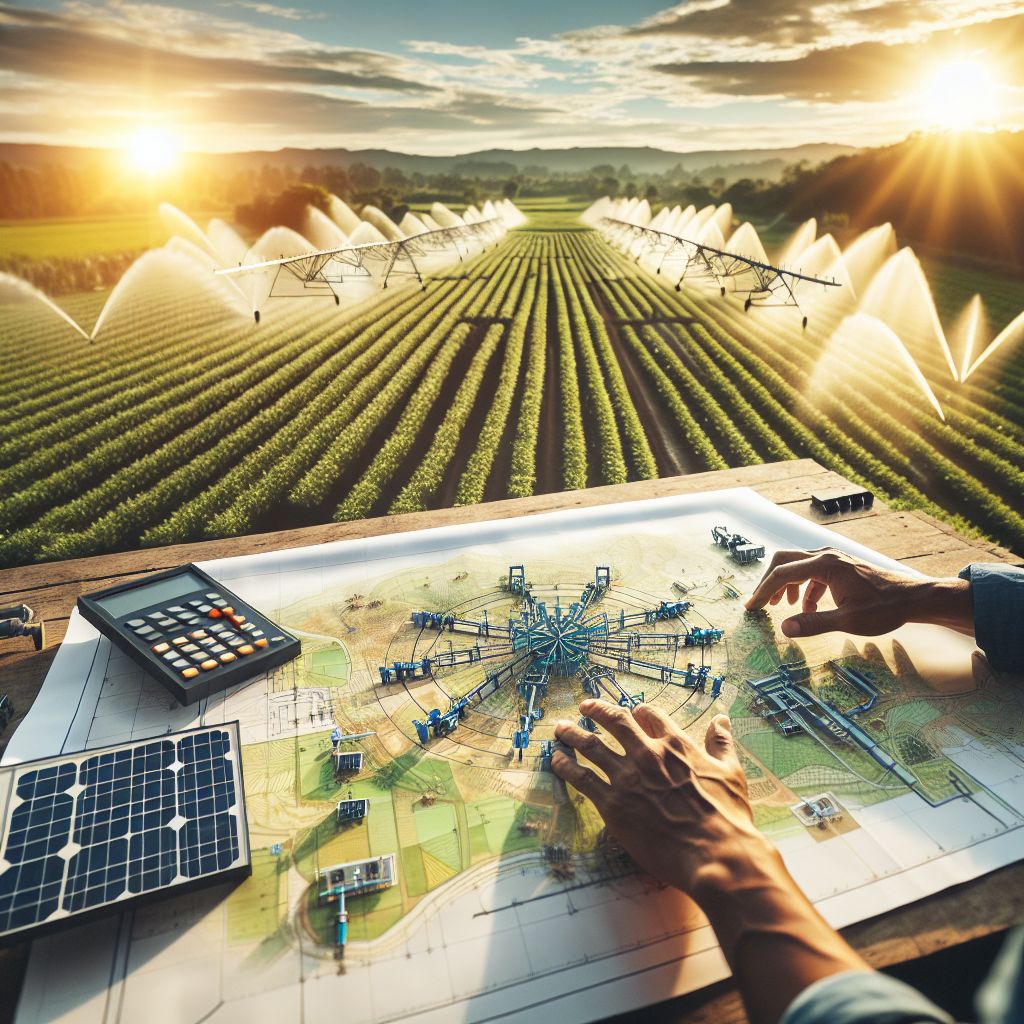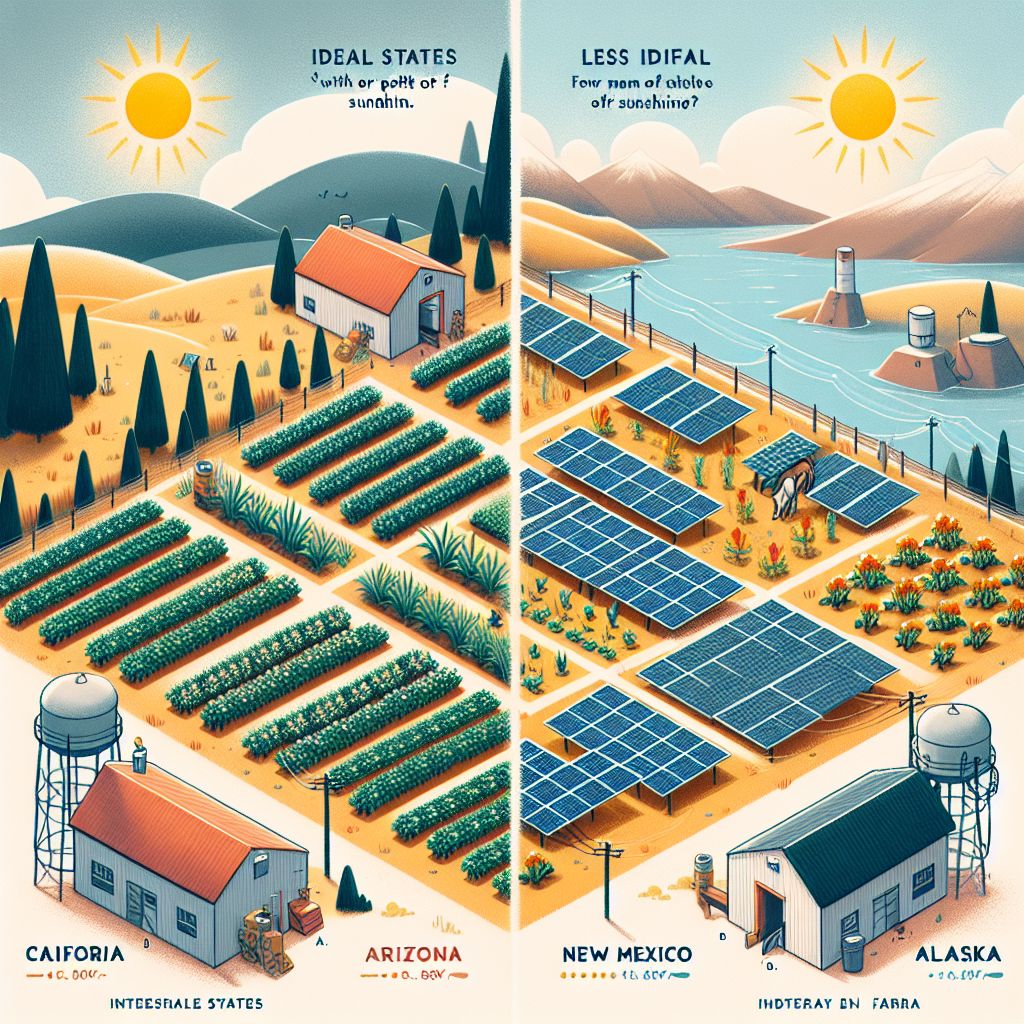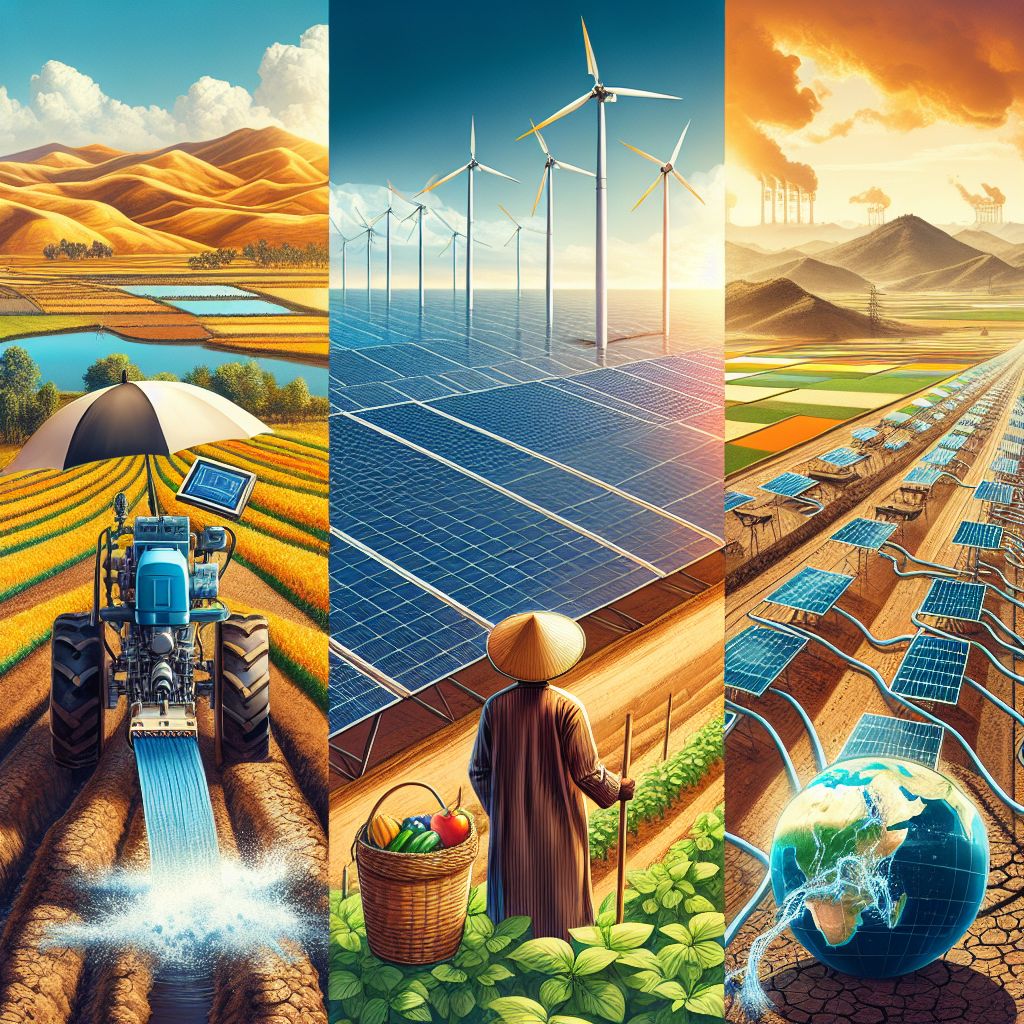
Summary
The effectiveness of solar irrigation systems is largely determined by your farm’s location and the amount of sunlight it receives.
Understanding the topography of your farm is essential to properly place solar panels and maximize their efficiency.
Calculating the sun hours specific to your farm’s location will help you determine the best setup.
Selecting the right solar panels and positioning them correctly is key to maximizing the system’s energy output.
Investing in the right water pumps and storage solutions is crucial to maintaining a reliable irrigation system.
Reaping the Sun’s Benefits: The Role of Location in Solar Irrigation Systems
When it comes to using solar energy for farm irrigation, location isn’t just a setting—it’s a main player. Just as plants need the right combination of sun and water to grow, solar irrigation systems need the right location to function effectively. But it’s not just about choosing a sunny spot. You have to consider how the sun travels across your land, the terrain’s shape, and even the type of crops you’re cultivating.
Optimal Location for Solar Irrigation
Identifying the optimal location for your solar irrigation system begins with a basic fact: the more sunlight your solar panels receive, the more energy they can produce. But it’s not just about the amount; it’s also about the intensity. The angle of the sun’s rays impacts how much energy your panels can absorb. That’s why the best location for your solar panels isn’t just the place with the most sunlight but the one where the sun’s energy is most direct.
First and foremost, you should ensure that your solar panels are not shaded by trees, buildings, or other structures, particularly during the hours of peak sunlight. A shaded solar panel is as useful as a wind turbine in a room with no wind – it won’t produce much power. So, it’s crucial that your panels have a clear, unobstructed path to the sun all day long.
Topography’s Impact: The Importance of Hills and Valleys
Topography is a crucial factor to consider. If your farm is hilly or has valleys, you need to think about how this affects sunlight exposure. For instance, a solar panel located in a valley may receive less sunlight than one on a hill that faces the sunrise. Here’s what you need to remember:
In the Northern Hemisphere, south-facing slopes usually get more sunlight during the day.
Valleys can often be shadowy, especially if they’re surrounded by higher terrain.
Higher areas are often better for solar panels because they usually have fewer obstructions.
But keep in mind, every farm is different. What works for one may not work for another. It’s all about tailoring the system to the specific features of your land.
Determining Sun Hours for Maximum Efficiency
For the best performance from your solar irrigation system, it’s essential to understand how many sun hours your farm receives. Sun hours are the daily hours during which your panels can generate their rated power. This doesn’t simply mean the time from sunrise to sunset. Rather, it’s the period when the sun is sufficiently high and bright to power your panels effectively.
Measuring sunlight hours can be complex, but here’s a simpler way to do it:
Observe the sun’s path across your land throughout the day and during different seasons.
Use solar calculators available online or ask a solar professional for accurate measurements.
Take into account how the changing seasons might alter the amount of sunlight your farm receives.
Right below is a table outlining the sun hours for maximum efficiency for a solar irrigation system.
| State | Average Sun Hours per Day | Factors Affecting Sun Hours |
|---|---|---|
| California | 7-8 hours. 2 | – Abundant sunshine with over 300 sunny days per year. 1 – Low levels of cloud cover and atmospheric conditions that reduce sunlight. 2 |
| Texas | 6-7 hours. 2 | – High levels of direct sunlight, especially in western regions. 2 – Some variation in sun hours due to weather patterns across the state. 2 |
| North Carolina | 5-6 hours. 2 | – Moderate sunshine levels with some cloud cover and precipitation. 2, 3 – Seasonal variations in sun hours throughout the year. 2 |
| Florida | 6-7 hours. 2 | – Abundant sunshine, especially in southern regions. 2, 3 – Potential for increased cloud cover and thunderstorms during certain seasons. 2 |
| Arizona | 7-8 hours. 2, 4 | – Exceptionally high levels of direct sunlight and clear skies. 2, 4 – Potential for dust storms and extreme heat that can impact solar panel efficiency. 2, 4 |
The key factors that influence the sun hours in these states include the overall sunshine levels, cloud cover, precipitation, and environmental conditions that can affect the performance of solar panels. States like California, Texas, and Arizona tend to have the highest average sun hours per day, making them well-suited for solar-powered irrigation.
Understanding the amount of sunlight your farm gets allows you to predict how much energy your solar irrigation system will generate and whether it will be enough to meet your irrigation needs.

Creating Your Solar Irrigation System
Now that you grasp the significance of location, let’s discuss the specifics of creating a solar irrigation system that flourishes. It’s akin to assembling a puzzle where each piece must be perfect for the entire image to form. You have your solar panels, your water pumps, and your storage solutions—all of which must operate in unison.
Panel Placement: East-West vs. North-South
The placement of your panels can make or break your solar irrigation system. It might seem like the obvious choice is to point all your panels south (or north if you’re in the Southern Hemisphere), but it’s not always that straightforward. An east-west orientation can sometimes gather more sunlight as the sun moves across the sky, especially if you’re working with a small area or oddly shaped land.
Here’s a simple guide to how to position your panels:
North-South: This orientation is ideal for taking advantage of the sun at its peak, which is usually around noon.
East-West: This setup allows for even sunlight capture during the morning and afternoon. This is perfect if you have longer days with milder sunlight.
Since the perfect orientation depends on your specific location and daily sunlight patterns, it’s a good idea to consult with a solar expert to ensure you get the orientation just right.

Get Growing: Choosing the Perfect Spot for Your Solar Irrigation System
Once you’ve got a solid plan, you’re ready to set up your solar irrigation system. The perfect location isn’t just a place with plenty of sun—it’s the groundwork for the success of your farm.
Setting up your System: The Importance of Location
Installing your solar irrigation system correctly is crucial for its effectiveness. It’s much like planting a seed – you want to ensure it is done correctly so it can thrive. Your installation team should have a thorough understanding of your farm’s layout and the design of the system. Accuracy is crucial, as even a minor misalignment can impact the performance of your solar panels.
Keep it Going: Sustaining Your Eco-Friendly Investment
Once you’ve got your system up and running, the job isn’t done—it’s just started. Regular maintenance is the key to keeping your solar irrigation system performing at its best. This includes cleaning your panels, checking connections, and making sure pumps are working efficiently. Consider it like maintaining your garden; a little attention can make a big difference.
Take for instance a farmer who saw a 10% decrease in water flow. They checked their solar panels and found a build-up of dust and leaves, which was blocking the sunlight. A quick cleaning routine brought their system back up to full capacity.
Maintenance isn’t just about repairing issues, it’s about stopping them from happening in the first place. That’s why it’s so important to keep an eye on the health of your system for long-term sustainability.
Seasonal Strategies: Adapting to Changing Sunlight
The sun’s path changes with the seasons, and so should your approach to solar irrigation. In the summer, you might have an abundance of sunlight, while in the winter, the days are shorter and the sun sits lower in the sky. Adapting your system to these changes ensures that your crops get the right amount of water year-round.
Here are some strategies that vary by season:
Change the position of your solar panels to align with the sun.
Organize your watering routine to coincide with the sunniest parts of the day.
Refer to weather predictions to be ready for periods of less sunlight.
By aligning your solar irrigation system with the natural world, you can develop a farming method that is not only sustainable, but also efficient.

Where Should You Place Solar Panels for Your Farm’s Irrigation System?
The best place to set up your solar panels isn’t just based on where you are—it’s also about where your property is best suited for them. You should look at states that have plenty of sunlight, policies that support solar energy, and possible financial incentives for using solar energy. States such as California, Arizona, and New Mexico are often the first choices because they have many hours of sunlight each year and regulations that are friendly to solar energy.
Top States to Install Solar Panels for Farm Irrigation Systems
Below are some of the top states for solar irrigation systems:
California: Thanks to its Renewable Portfolio Standard and other incentives, California is leading the way in the adoption of solar energy.
Arizona: Famous for its sunny days, Arizona is the perfect place to generate solar power.
New Mexico: This state offers tax credits and loan programs to support the use of solar energy systems.
These states not only get plenty of sun, but they also have the infrastructure and incentives to support the integration of solar energy into farming.
Least Ideal States for Solar-Powered Irrigation Systems on Farms
Conversely, states with inconsistent sunlight, like Alaska, or those lacking strong solar energy policies may not be as beneficial for implementing solar irrigation systems. This doesn’t mean it’s impossible, but you may encounter more obstacles and require a more substantial setup to make up for fewer hours of sunlight.
Right below is a table outlining the worst states for using solar panels for farm’s irrigation systems.
| State | Reason Why These States Are the Worst States to Use a Solar Irrigation System |
|---|---|
| Alaska | – Harsh, cold climate that can damage solar panels and reduce their efficiency. 2 – Sparse population, limiting the number of potential users for solar-powered irrigation. 2 |
| Arkansas | – Low levels of direct sunlight, averaging only 4.4 hours per day. 3 – Heavy cloud cover that further reduces access to sunlight needed for solar panels. 3 |
| Florida | – Lack of mandatory statewide net-metering policies, which are crucial for solar adoption. 1 – Absence of community solar programs to expand solar access. 1 |
| Texas | – Lack of mandatory renewable portfolio standards to drive solar market growth. 1 – Absence of third-party solar ownership models that have fostered distributed solar elsewhere. 1 |

Worldwide View: Solar Irrigation Systems in Different Countries
When we look at other countries, we see numerous success stories and inventive ways of using solar irrigation. Countries like India, China, and those in Africa are using solar power to support farmers and guarantee food security.
Success in Various Climate Conditions
For example, in India, solar irrigation has revolutionized small-scale farming by enabling farmers to cultivate crops even in the dry season. In China, the government has made substantial investments in solar technology to increase agricultural output.
Overcoming Obstacles: Global Ingenuity
However, these triumphs aren’t without their obstacles. In areas with less dependable sunlight or more complicated landscapes, farmers have had to think outside the box, merging solar power with other types of renewable energy or employing inventive storage methods to guarantee a steady water supply.
Learning From Worldwide Farming: The Importance of Adapting and Transferring Technology
Farmers across the globe can benefit from sharing their knowledge and technology. This cross-border exchange of experience and ideas is crucial for the development of sustainable farming practices.
In Conclusion:
When it comes down to it, the influence of location on farm solar irrigation systems is incredibly important. Regardless if you’re farming in the sunny valleys of California or the diverse climates of the international farming community, knowing and using your unique environment to your advantage is crucial for sustainability and success. With the correct knowledge, tools, and support, farmers can build resilient, energy-efficient irrigation systems that can withstand the test of time and weather.
Commonly Asked Questions
Let’s tackle some frequently asked questions about solar irrigation systems to help clear up any remaining confusion.
Is it possible for solar irrigation systems to work in areas with less sun?
Indeed, solar irrigation systems can function in areas with less sun, although they may need more panels or hybrid systems that include other types of renewable energy to maintain consistent performance.
How can I determine the best location for my solar panels?
When trying to determine the best location for your solar panels, you should take into account things like the number of hours of sunlight, any potential shading, and the angle of the sun. You can use tools like a solar path calculator or get professional advice to get an accurate idea.
What are the environmental advantages of using a solar irrigation system?
Solar irrigation systems have several environmental advantages, such as reducing dependence on fossil fuels, decreasing greenhouse gas emissions, and encouraging sustainable water use.
Does location have an impact on solar panels?
Indeed, the location can have a profound impact on the efficiency of solar panels. Elements such as geographic latitude, weather conditions, and terrain all contribute to the amount of sunlight your panels will be able to capture.
What are the top states to establish a solar irrigation system for a farm?
California: due to its robust solar incentives and high levels of sunlight.
Arizona: due to its consistently sunny climate.
New Mexico: due to its favorable policies and solar tax credits.
Keep in mind, the optimal state for your solar irrigation system will be determined by a mix of factors, such as the availability of sunlight, state policies, and the unique needs of your farm.







Leave a Reply